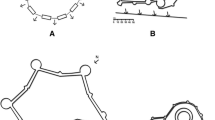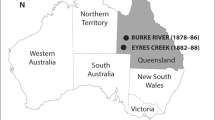Abstract
Recent excavations at the Addison Plantation site (18 PR 175) resulted in the recovery of an assemblage of flintlock mechanisms and firearms hardware from several early 18th-century components. These materials were part of an armory maintained by Thomas Addison in conjunction with his duties as a colonel in command of the Prince George’s County militia. Analysis of this assemblage in the context of Addison family history and the early 18th-century history of the Potomac region provides insights into the duties of provincial militia officers and the evolving role of the militia on the Potomac frontier. Based on this analysis, the militia’s development from the early 17th century through the mid-18th century may be divided into two distinct periods: 1622–ca.l714, when the militia was very active as the primary defense of the frontier; and ca. 1715–1764, a period of decline during which the Prince George’s County militia was utilized primarily to prevent insurrection and to recapture runaway slaves.
Similar content being viewed by others
References
Baird, Donald 1987 The Indian Trade Gun and Gunflints from Burial 8 at the Pahaquarra Site, Warren County, New Jersey. Bulletin of the Archaeological Society of New Jersey 42:1–8.
Beaudry, Mary G. 1982 Fort Christanna and the Frontier and Fur Trade Artifact Patterns: A Test. Conference on Historic Site Archaeology Papers, 1979 14:45–58.
Blackmore, Howard L. 1962 British Military Firearms. Arco, New York.
Brown, M. L. 1980 Firearms in Colonial America: The Impact on History and Technology, 1492–1792. Smithsonian Institution Press, Washington, D.C.
Carp, E. Wayne 1986 Early American Military History: A Review of Recent Work. Virginia Magazine of History and Biography 94(3):259–284.
Darling, Anthony D. 1970 Red Coat and Brown Bess. Historical Arms Series No. 12. Museum Restoration Service, Alexandria Bay, New York.
Grimm, Jacob L. 1970 Archeological Investigation of Fort Ligonier: 1960–1965. Carnegie Museum, Pittsburgh, Pennsylvania.
Hamilton, T. M. 1976 Firearms on the Frontier: Guns at Fort Michilimackinac 1715–1781. Reports in Mackinac History and Archaeology No. 5. Mackinac Island State Park Commission. TriKraft, Williamston, Michigan.
Hanson, Lee H. 1968 The Excavation of the New Ordnance Storehouse at the Fortress of Louisbourg, Operation 1L32. Manuscript Report Series 54. Parks Canada, Ottawa.
Hanson, Lee, and Dick Ping Hsu 1975 Casemates and Cannonballs: Archeological Investigations at Fort Stanwix, Rome, New York. National Park Service, Washington, D.C.
Harrington, J.C. 1957 New Light on Washington’s Fort Necessity. Eastern National Park and Monument Association, Richmond, Virginia.
Heinton, Louise Joiner n.d. Map of Tracts of Land Laid Out in Charles and Calvert Counties Prior to April 1, 1696.
1972 Prince George’s Heritage, Sidelight on the History of Prince George’s County, Maryland, from 1696–1800. Privately printed, Baltimore, Maryland.
Isaac, Rhys 1982 The Transformation of Virginia 1740–1790. University of North Carolina Press, Chapel Hill.
Karinen, Arthur Eli 1958 Numerical and Distributional Aspects of Maryland’s Population, 1631–1840. Unpublished Ph.D. Dissertation, Department of Geography, University of Maryland, College Park.
Kulikoff, Alan 1978 The Origins of Afro-American Society in Tidewater Maryland and Virginia, 1700 to 1790. William and Mary Quarterly 35(3):226–259.
Lopez, Julius 1978 The History and Archaeology of Fort Independence on Tetard’s Hill, Bronx County, N.Y. Bulletin: New York State Archaeological Association 73:1–28.
Maryland Archives 1883- Archives of Maryland. 72 Volumes to date. Maryland present Historical Society, Baltimore.
Maryland Hall of Records 1727 Prerogative Court Inventories 12. Annapolis.
Miller, Henry M. 1984 Colonization and Subsistence Change on the 17th Century Chesapeake Frontier. Ph.D. Dissertation, Department of Anthropology, Michigan State University, Lansing. University Microfilms International, Ann Arbor.
Millett, Allan R., and Peter Maslowski 1984 For the Common Defense: A Military History of the United States of America. Free Press, New York.
Noël Hume, Ivor 1969 A Guide to Artifacts in Colonial America. Alfred A. Knopf, New York.
1982 Martin’s Hundred. Alfred A. Knopf, New York.
Peterson, Harold L. 1956 Arms and Armor in Colonial America, 1526–1783. Stackpole, Harrisburg, Pennsylvania.
Pollard, H. B. C. 1973 A History of Firearms. Lenox Hill, New York.
Rutsch, Edward S., and Sally Skinner 1972 Research Done in 1971 on Fort Nonsense, Morristown National Park, Morristown, New Jersey. Northeast Historical Archaeology 2(1):35–43.
Shea, William L. 1982 The First American Militia. Military Affairs 46(1): 15–18.
Stewart, W. Bruce 1985 The Structural Evolution of Fort Frontenac. Northeast Historical Archaeology 14:38–49.
Stone, Lyle M. 1974 Fort Michilimackinac 1715–1781: An Archaeological Perspective on the Revolutionary Frontier. Publications of the Museum. Michigan State University, Lansing.
Swauger, James L., and Arthur M. Hayes 1959 Historic Archaeology at Fort Pitt, 1953. Anthropological Series 4. Carnegie Museum, Pittsburgh.
Virta, Alan 1984 Prince George’s County: A Pictorial History. Donning, Norfolk, Virginia.
Author information
Authors and Affiliations
Rights and permissions
About this article
Cite this article
McCarthy, J.P., Snyder, J.B. & Roulette, B.R. Arms from Addison Plantation and the Maryland militia on the Potomac frontier. Hist Arch 25, 66–79 (1991). https://doi.org/10.1007/BF03373505
Published:
Issue Date:
DOI: https://doi.org/10.1007/BF03373505




